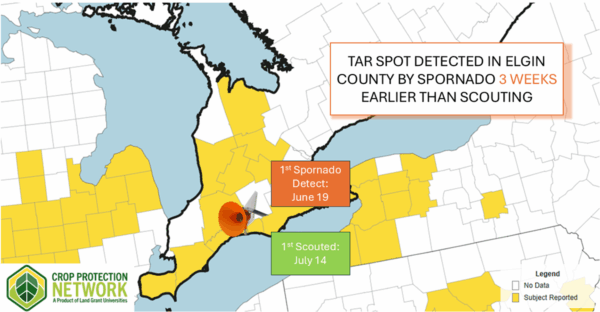In The News
Tar Spot in Ontario: 2025 Update
Tar spot continues to be a growing concern for Ontario corn growers, and 2025 has been no exception. This year, the disease followed a pattern similar to previous seasons—first appearing at low levels in early July in Elgin County. Hotter, drier summer conditions kept tar spot development relatively low until August, when more favorable weather led to a late-season resurgence. With fungicide applications in place, yield losses are expected to be less severe than in recent years.
In fact, tar spot has quickly become Ontario’s most damaging corn disease. In 2024, it was the top yield-reducing disease in the province, responsible for an estimated 5.9 million bushels in losses (Crop Protection Network).
First Scouting Report vs. Spornado Early Warning
The first scouting report of tar spot in Ontario corn was on July 14, 2025, in Elgin County. This aligns closely with previous years.
But what’s remarkable is that Spornado detected tar spot spores in the air on June 19, 2025 – more than three weeks before visible disease symptoms appeared in the field. This early warning provided growers with valuable time to assess disease risk and make more informed spray decisions.
This gap between spore presence and visible symptoms demonstrates why in-field air sampling is so valuable. Tar spot often establishes before anyone sees it on leaves, meaning farmers relying on scouting alone risk detecting the disease too late to prevent losses.
Resources
For more details on tar spot development in Ontario, see the latest updates from Field Crop News and the Crop Protection Network. Both provide timely scouting reports, management strategies, and research updates to help growers stay informed.
 Spornado Takeaway: Why Early Detection Matters
Spornado Takeaway: Why Early Detection Matters
Spornado’s ability to detect tar spot spores weeks before symptoms appear gives growers the chance to make proactive, data-driven spray decisions. By staying ahead of disease, farmers can reduce unnecessary applications, protect yields, and improve return on investment.
